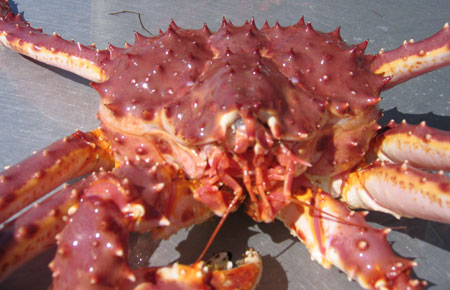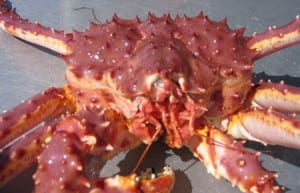The fall red and blue king crab fishery has been opened only twice in the past decade, in 2005 and 2011.
The numbers are still at historically low levels.
Joe Stratman is Alaska Department of Fish and Game’s lead crab biologist for Southeast.
“The stock health in the survey areas ranged from below average to poor,” Stratman said.
He and other biologists track two groups of king crab in Southeast: the legal biomass and mature biomass. Basically, the legal crabs are crabs that are big enough to be harvested in the commercial fishery. The mature biomass also includes crabs that are sexually mature but not big enough to be landed.
“Both mature and legal surveyed biomasses declined on the average of seven percent annually from 2001 to 2013,” Stratman said.
Since then, however, there have been some small increases.
Stratman got out a piece of paper to show me a graph.
“This is what I mean here,” he said. “2013 was kind of the low point I guess for legal and mature biomass, things had been ticking down like I said since 2001 but we have seen some increases since 2014.”
The growth has been modest region wide but it’s an increase none the less.
“We are generally seeing things trending up since 2013 as far as the biomass estimates go,” Stratman said.
The state can open Southeast’s commercial season if the estimated amount of legal size, male king crab tops a minimum threshold of 200,000 pounds. But that wasn’t close to happening this year.
Fish and Game monitors the king crab population through annual catch surveys in seven areas called CSAs. They also work with local fishermen on a mark and recapture project.
“We can charter industry vessels and they can use the gear that they want to use, they can use the bait that they want to use and within the bays, fish the areas that they want to fish to basically come up with another biomass estimate that we can kind of hold up against our CSA estimate,” Stratman said.
The mark and recapture project also shows low numbers of king crab.
The Southeast commercial fishery for king crab has been below the threshold for most of the last decade. The fishery is lucrative if it does happen. In the last opening five years ago, fishermen got $10/pound.
Red king crabs are the largest shell fish in the state. They can live up to 20 to 30 years and can have a leg span of five feet.
Blue king crabs are incidental catches for fishermen representing only about one percent of the king crab population in Southeast.
While commercial fishing is closed the personal use fishery has been open in limited areas allowing for one crab a day.











